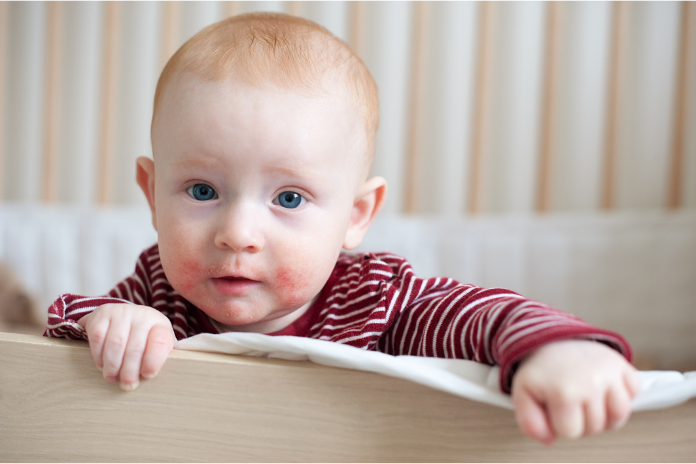Allergy is an abnormal reaction of the body to any substance and baby allergies are very common. It is basically an overreaction of the immune system that causes harm to the body itself. Allergen may include a wide range of substances like pollen, milk, peanuts, chemicals.
Age
Baby allergies may develop with exposure to the outside environment. Or with weaning and the introduction of different food items in their dietary chart. An allergy to indoor allergens like dust or food usually develops at 1-2 years. Seasonal allergy develops by age of 3-5 or as late as 10 years.
When To Suspect?
When the child starts developing symptoms like:
- Coughing
- Runny nose
- Diarrhea
- Wheezing
- Nausea, vomiting
- Red rash around the mouth
- Swelling in legs and arms
- Hives or rash
The parents should suspect allergic reactions and report to a doctor to determine the cause of an allergy. This will help prevent further exposure to the specific antigen. It will also diminish the risk of the development of symptoms for baby allergies with increased severity in the future.
The common signs are :
- Eczema – it is the development of rough, itchy, inflamed blisters that might be painful
- Urticaria – these are red, itchy welts on the skin and are called hives when related to food allergy.
- Rhinorrhoea – stuffy or running nose
- Eye symptoms – redness, itching, watering from eyes
Types of Baby Allergies
Seasonal Allergies
The babies may develop allergies to seasonal allergens like pollens from weed, grass or plants, mold, dust mites, dander. They usually do not present before the age of 2-3 years. Allergies can be differentiated from respiratory infection on basis of the absence of fever, itchy eyes, dry cough, and watery, clear mucus discharge.
The symptoms can be prevented and relieved by simple measure like:
- Keeping the windows closed and turning on the air conditioner to keep pollen out of your home
- Placing effective filters in the furnace and chimneys
- Cleaning homes regularly to control allergens. Dusting frequently, washing beds linens often in hot water are important. More include using a vacuum that has a HEPA filter, and removing drapes and carpets
- Limiting outdoor activities on days when the pollen count is high
- Taking shoes off before entering the house
- Taking a shower or bath after coming from outside
- Washing clothes (including jackets and other outerwear) regularly to remove pollen
- Bathing pet animal once a week as the fur can pick up pollen
- Wearing goggles while going outside to keep the pollen out of eyes
Indoor Allergies
These baby allergies may be due to indoor allergens like dust, pet fur, cigarette smoke. The symptoms are similar to that of seasonal allergies. Simple prevention measures include:
- Changing air duct filters frequently
- Avoiding carpeting as it can collect dust
- Sweeping and vacuuming regularly to remove small dust particles
- Using allergen-proof zip-up covers for mattresses, box springs, and pillows
- Washing linens in hot water regularly
- Placing soft toys in a plastic, sealable bag. Putting them in the freezer for at least 5 hours once a week so as to kill dust mites
- Avoid using humidifiers and vaporizers. They add moisture to the air and increase the risk of mold and dust mites
Food Allergies
Food allergies include allergies to peanuts, egg, fish, soy, wheat, nut cow’s milk. Symptoms like belly pain, diarrhea, urticaria, hives, running nose, itchy eyes may indicate a food allergy. These symptoms might be life-endangering. Like a sudden drop in bp, bronchospasm causing difficulty in breathing, dizziness if they are due to anaphylactic reaction. Early detection of the development of allergy and the cause of allergy is important. Education on preventing allergen exposure, and immediate treatment of anaphylactic reaction are key to prevent harmful effects of allergy.
Breast milk is an immunologically complex substance that might itself be a cause of allergy in babies. However, its protective function is much more. Studies have indicated milk formulas, cow’s milk, soy protein to be of higher risk to the baby. Thus exclusive breastfeeding is encouraged for up to the age of 6 months at least.
To prevent the development of food allergy in babies, mothers should –
- Avoid probable common allergens in their own diet when the baby is in breastfeeding dependent phase of life
- Breastfeed the baby exclusively up to 6 months of age
- Introduce solid food to baby slowly and only when the baby is ready for it, i.e., after 6 months of age preferably
- Keep eczema, if any, under control with the help of a doctor
- Look out for signs of any intolerance and immediately consult a doctor
Diagnosis
It is important to identify baby allergies and the allergen causing allergy timely as severe reactions may include even anaphylactic shock. Some common tests include –
- Blood ige levels – these are antibodies involved in the mechanism of development of type 1 hypersensitivity reaction
- Eosinophil count – these cells flare up after an allergic reaction
- Skin prick test – this is a simple test that involves injecting a small amount of allergen protein into the skin, and wheal and flare reaction indicates an allergy to the protein
Treatment
Treatment of baby allergies goes hand in hand with prevention and avoiding exposure or contact with allergen after correct identification. Medical treatment includes –
- Antihistaminic – in the form of nasal spray, pills, topical creams
- Immunotherapy – this involves slow exposure to the allergen over years gradually increasing the dose to develop immunity
- Epinephrine – it may be given in emergency conditions of anaphylaxis
References:
https://www.ncbi.nlm.nih.gov/pmc/articles/pmc2805592/
https://pubmed.ncbi.nlm.nih.gov/28890990/
